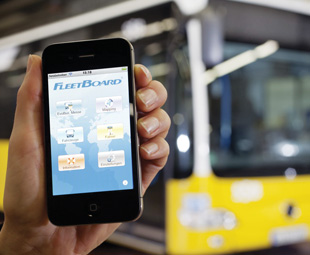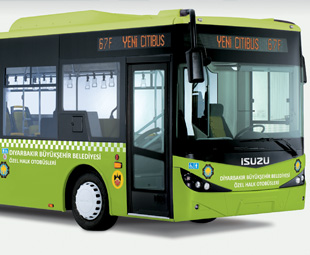FleetBoard is watching (and guiding) you!

FRANK BEETON reports that Daimler has developed a bus-specific version of its well-known FleetBoard solution, and that an interesting Turkish joint venture could highlight an innovative way of midibus construction.
The increasing level of technology applied to motor vehicles is a subject for constant debate, the main focus recently shifting to autonomous, or self-driving, vehicles. It is notable that research recently carried out by the University of Michigan-Dearborn, in the United States, identified 2020 as the year in which the automated vehicle era is most likely to begin.
Respondents to the research predicted that, initially, some back-up reliance on a driver would be retained, followed by progressive evolution to full automation around 2030. In the interim, the incidence of devices and services intended to assist drivers and operators to more effectively manage their vehicles is likely to increase.
Daimler’s FleetBoard intelligent management service is one such medium, enabling more effective management control to be exercised. The system makes use of telematics-supported internet technology to enable bidirectional information exchange with vehicles and their drivers, in real time, while they are on the road.
At the recent FIAA International Bus & Coach Trade Fair held in Madrid, Spain, FleetBoard introduced a new optimised modular portfolio specifically intended for bus operators.
Utilising its integral “Messaging” and “Logistics” functionalities, the bus-specific FleetBoard service works through the DispoPilot.guide integrated in the vehicle, together with its seven-inch colour display. This enables the driver to send and receive messages relating to navigation, and the exchange allows the traffic office to determine the expected arrival time at destination.
The system also measures performance analysis, trip recording and driving behaviour in terms of cruise control, speed limiter and Predictive Powertrain Control (PPC) usage, as well as the upper and lower speed tolerances defined by the driver.
On the Euro-6 Mercedes-Benz and Setra bus and coach models, AdBlue consumption and tyre pressures are also monitored, allowing for the more effective planning of vehicle servicing. Driver behaviour can then be influenced to optimise important operating parameters, such as fuel consumption.
Daimler’s Predictive Powertrain Control technology operates in conjunction with the vehicle’s adaptive cruise control system, and an on-board GPS, to coordinate engine and transmission management, using controlled coasting and auxiliary brake functions to simulate the actions of a highly skilled driver. This ensures that the vehicle achieves optimum efficiency and performance.
Isuzu’s Turkish buses
The technical layout of truck chassis presents some design challenges when used in bus applications, particularly in respect of the positioning of the driving position in relation to the front-mounted engine. This usually dictates the location of the passenger entry door behind the front axle, or, in the case of a front entrance, it results in a narrow and steep passageway leading from the entrance into the saloon.
 Anadolu Isuzu, a joint venture between Isuzu Motors, Itochu Corporation and Turkish interests, which was established in Turkey in 1984 to build light-duty trucks and midibuses, has found a way to overcome this challenge.
Anadolu Isuzu, a joint venture between Isuzu Motors, Itochu Corporation and Turkish interests, which was established in Turkey in 1984 to build light-duty trucks and midibuses, has found a way to overcome this challenge.
Its range of midibuses, midicoaches and low-entry city buses utilise monocoque – or chassisless – construction, meaning that the major driveline components can be positioned optimally to suit passenger configurations. The city buses have their engines positioned at the extreme rear, which allows for up to three low-entry doors to be provided for boarding and alighting passengers.
The Anadolu Isuzu range provides accommodation from 16 to 39 seated passengers, while the Citibus low-entry model can carry up to 69 seated and standing passengers. Power is provided by various derivatives of the Isuzu 4HK1 engine family, while transmission options include manual, power-assisted and automatic units.
Clearly, the monocoque construction technique is more expensive and less flexible, but it has struck a chord with operators in its home country, where Anadolu Isuzu is the second-biggest seller of midibuses. It also developed a healthy export business to northern African and European markets. Total vehicle production since the formation of the joint venture stands at nearly 150 000 units.
Published by
Focus on Transport
focusmagsa




